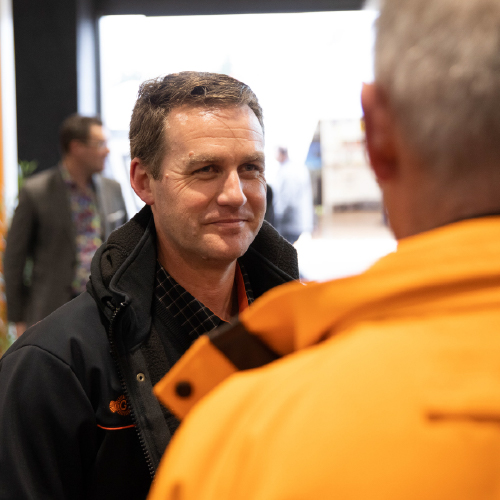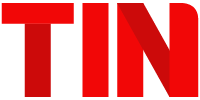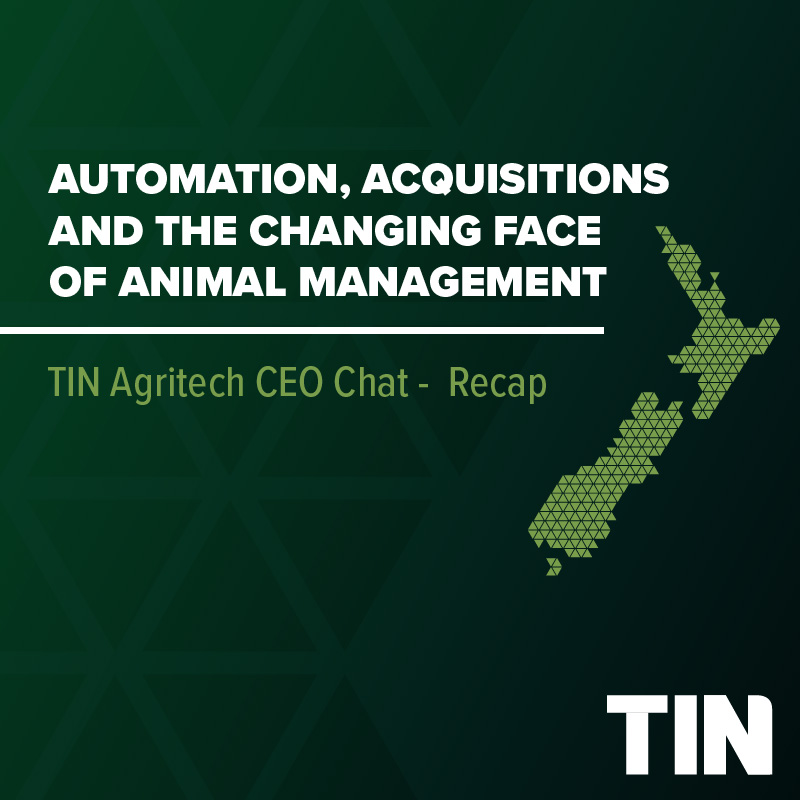TIN AGRITECH CEO Chat: 26 May, 2021
In the lead-up to the launch of its second annual NZ Agritech Insights Report, TIN hosted a virtual roundtable for some of its key Agritech member companies, bringing together CEOs from Gallagher Group, LIC and Bluelab to discuss the issues and opportunities facing the sector.
Hosted by Greg Shanahan, the discussion touched on the effects of COVID-19 on the industry, as well as future prospects. Automation, acquisitions and the changing face of animal management were just some of the themes covered.
“I believe agtech has got a massive future because at the end of the day we’re developing products that allow people to eat. I can’t see how that can be a bad thing.”Greg Jarvis, CEO, Bluelab
“The agriculture industry in general is very buoyant,” said Kahl Betham, CEO & Executive Director of Gallagher, and a 23-year veteran of the company. “Our animal management business ran at around 20% higher last year than the previous year, and the first few months of this year are looking even stronger.
“We’ve been surprised how well the agriculture industry has fared, despite the challenges of COVID-19. We thought at the beginning of last year’s lockdowns that we were holding too much stock, but that turned out to be a competitive advantage. Having the ability to supply with control of our manufacturing, coupled with some strong natural growth in the industry has netted good results for us.”
“Getting access to electronic components as lead times are lengthening is a risk we have to manage, and we’re mitigating that as best we can. Added to that, the number of containers coming to and from New Zealand, and the cost of containers and air freight is also a challenge. Our teams are working hard to ensure we meet the demand of Gallagher technology for our customers.”
This was a view echoed by Wayne McNee, CEO of Livestock Improvement Corporation (LIC), the agritech and herd improvement co-operative.
“The dairy industry is showing good growth, and the underlying fundamentals of the industry are very strong,” he said. “In addition, the high-tech advanced end of our portfolio is selling very well and our biggest challenge is keeping up with demand. We were fortunate to be able to keep operating throughout the disruptions of last year, and, I’m happy to say we’re in our financial guidance range for the financial year.”
“We’ve invested in automation and robotics in our laboratories, so it meant we didn’t need people standing side by side. That automation has enhanced our systems and the benefit of that investment meant that we could keep operating throughout the lockdown.
“Along with everyone else, we obviously had challenges with getting supplies to run our labs during lockdown. Our farmer shareholders rightly have little tolerance for us not delivering, and although we had some challenges we managed to keep things going, which was great.”
“We’ve invested in automation and robotics in our laboratories, so it meant we didn’t need people standing side by side. That automation has enhanced our systems and the benefit of that investment meant that we could keep operating throughout the lockdown.”Wayne McNee, CEO, Livestock Improvement Corporation (LIC)Greg Jarvis, CEO of Tauranga-based Bluelab, says they’ve remained globally focused and have seen a huge increase in demand, particularly out of the US and Europe as barriers have come down in the controlled environment space.
“We stood at the edge of the precipice about a year ago, fearing what was going to happen – and then the exact opposite has happened. We’ve seen substantial growth over the past year and we’re seeing this continue, five months into our new financial year.”
“Of course, we have barriers to growth along with everyone else. We’ve seen massive supply chain challenges; lead times are getting longer with some componentry and those sorts of things are really start to bite.
“In the past year, we’ve tried to get more diversity and resilience into our supply chain, but it’s often not just issues with the direct supplier, but also the supply source. We’re managing it well at the moment, and looking at what is driving that demand. It’s things like the Internet of Things and electric vehicles and then companies like us who are asking for increased supplies so they can build more stock.
Supply of talent was also identified as a barrier to growth by all three companies.
“We’re finding that because of the closed borders we’re now competing with other sectors for talent. For instance, a lot of money and effort is currently going into the development of gaming software,” said Greg.
“Software development was historically one of the key areas covered by our immigrant workforce, and that tap being turned off is a potential barrier for growth.”
“Our main challenge is going to be in our operational season,” said LIC’s Wayne McNee. “We hire close to 1,500 seasonal staff when we get into the artificial breeding and herd testing season. It’s a well-publicised fact that the dairy sector is short of workers – we’re having to recruit early and are finding the market difficult.”
“We’re trying to work with other companies in the sector who have seasonal requirements which might balance ours. That works to an extent. The labour-saving elements of robotics also reduces risk, and the robots happily work 24/7.”
“Farm automation provides great opportunities across the agritech sector,” added Wayne.
Gallagher has placed an even stronger focus on company culture over the past few years as it increased employee numbers substantially, and Kahl Betham believes this has been an important mitigating factor in talent recruitment and retention.
“We’ve had 350 people in the past year who’ve worked for us part and full-time who haven’t worked for us before. At least forty of those were involved with tech.
“We didn’t struggle to get good talent – it just took a bit longer,” he said.

Kahl Betham - Chief Executive Officer & Executive Director, Gallagher
Gallagher is also making greater investments into developing the talent pool from its local community.
“We’ve always enjoyed strong relationships with our local secondary school and tertiary institutions,” said Kahl. “We’re seeing if we can find pathways for students from the Waikato to help build our ecosystems of people locally, and incentivise people to stay in the region.”
Today, Gallagher’s workforce sits at around 800 people across four sites in New Zealand, and a total of well over 1000 fulltime employees when counting its offshore team throughout Australia, North America, Europe and Asia.
The panellists also discussed the key trends driving global agritech sector growth. The acceptance of data integration, a more stringent focus on food security and shortening supply chains, and increased environmental awareness were some of the factors identified. Partnerships are also key.
“In order to be successful in the next phase, we’re all going to have to partner and collaborate,” said Kahl Betham. Recent partnerships that Gallagher has announced include wearable and fenceless farms initiatives.
“It’s going to be an interesting time as the industry sorts out data interchange standards and allows AI to assess the multi-factorial components that can improve productivity,” he added.
The Government’s Agritech Industry Transformation Plan (ITP), which recommended ways to significantly lift the productivity, size and profitability of the sector, was also identified by the panellists as a welcome conduit to help bring the industry closer together, and to maximise government support.
“It’s early days, but there are some good things going on,” said Greg Jarvis. “There are still a lot of people working in isolation and not taking advantage of collaboration, but I believe that will change as the industry matures.
“Although we’re ultimately a nation of farmers, I think it’s agtech that will give us that will give us additional export revenue as there is a limit to the amount of food New Zealand can physically produce. Using our farms as a testing ground for new technology, we can help feed more of the world’s people.”
“I believe agtech has got a massive future because at the end of the day we’re developing products that allow people to eat. I can’t see how that can be a bad thing.”
Free TIN Report?
Trend Analysis. Research Tool. Prospecting List.
Become an official member of TIN and receive your copy of the Report at no added cost, plus discounts on exclusive events, opportunities to increase your company's profile, and connect with industry & government leaders.
Share this Post

